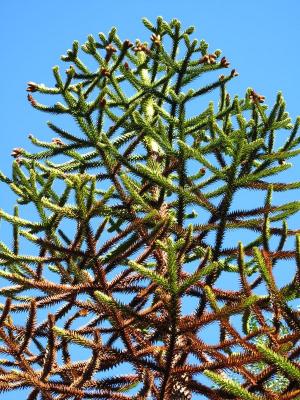Monkey Puzzle Trees an exotic addition to the garden
They have their own unique set of fingerprints, the same as us. They have opposable thumbs, the same as us. They use tools, too. They even have something most humans don’t have, all 264 known monkey species have tails, something apes and most humans don’t have.
But humans have gardens, and people have gone to the ends of the earth to bring back exotic plants and trees for our gardens. One exotic tree, Araucaria araucana from Chile and Argentina, where no monkeys live, grew in the mid-19th century in Great Britain, when an observer commented that the twisted, jumbled branches “would puzzle a monkey to climb it.” The tree has ever since been known as the “monkey puzzle tree.”’ Once used as a lumber tree to build everything from railway sleeper cars to snow skis and even airplanes, it is now protected in its native lands and grown mostly for its beautiful, if unusual, shape.
This stunning evergreen has sweeping horizontal branches that turn up at the tips. It will slowly grow to about 25 to 50 feet tall. The leaves are bright green and glossy, overlapping to completely cover every branch. The edges of the leaves are quite sharp, so this is best planted away from sidewalks, patios and play areas.
While only reliably hardy to USDA climate zone 7, the monkey puzzle tree can be grown in protected spots in the mild Delmarva peninsula.
To find monkey puzzle trees, ask your local garden center or nursery to special order them for you or try one of several exotic mail-order nurseries such as Raintree Nursery (391 Butts Road, Morton, WA 98356, phone 800-391-8892, online at www.raintreenursery.com) or One Green World, 6469 SE 134th Ave., Portland, OR 97236, phone 877-353-4028.
Plant your monkey puzzle tree in the early spring after all danger of frost is past. Choose an area with at least half a day of full sun with soil that drains naturally. Avoid soggy or damp areas.
Dig a hole twice as wide and twice as deep as the tree root ball. Fill the hole halfway back up with soil and set the tree in the hole. Fill the hole up around the roots, tamping the soil in to firm it. Water well to let the soil sink in and to close any air pockets. Your monkey puzzle tree will take a year or so to settle in, so you may notice that the first year’s leaves are smaller than normal. During this time keep it well watered, but not soggy.
Monkey puzzle trees produce pine cones filled with edible nuts, though it may take up to 30 years before your first crop. Only female trees produce nuts, and they need a male tree for pollination, so unless you plan on a large grove, you probably won’t harvest any nuts.
For the first few years, water your tree during any week that you get less than an inch of rain. No need to water during the winter. You can apply a good organic fertilizer around the tree, but it really is not necessary. Too much fertilizer can do more harm than good.
Monkey puzzle trees are rarely bothered by insects or diseases, but if you notice an infestation of thrips or spider mites, use a commercial pesticide to destroy them. Cut out and remove any dead or damaged branches.
Plant a monkey puzzle tree and with luck it can live hundreds of years. With its striking beauty and reptile-like foliage, the puzzle may be why we don’t plant more monkey puzzle trees.


















































